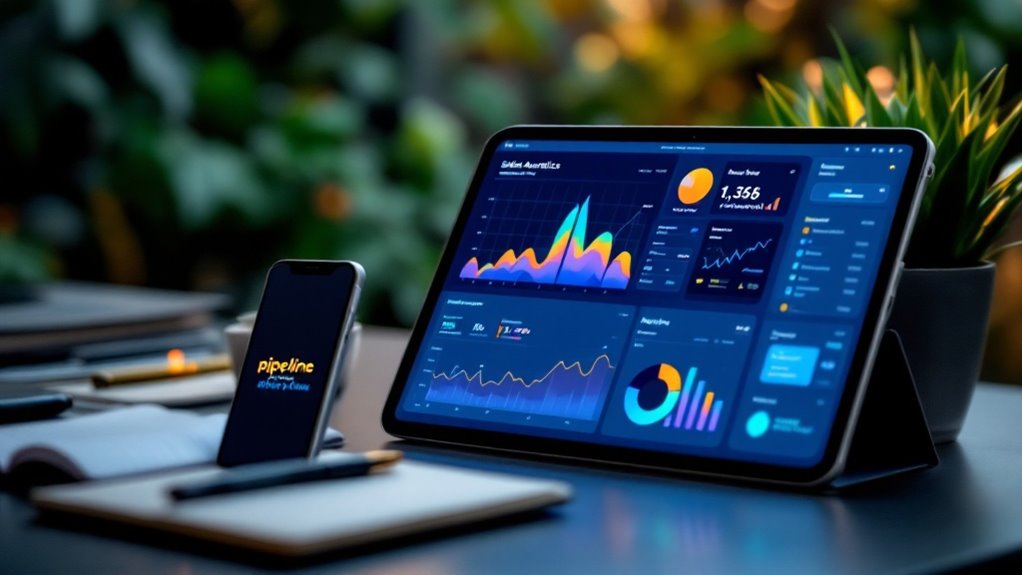Sales tracking software helps small businesses automate lead management and monitor performance through real-time analytics. Popular solutions like HubSpot Sales Hub and Zoho CRM offer essential features including pipeline visibility, customer relationship management, and mobile access. These tools typically integrate with existing business systems while streamlining routine tasks through workflow automation. Modern solutions range from free basic plans to extensive platforms with AI-driven insights. Exploring specific features reveals how this technology can transform daily operations.
Quick Overview
- HubSpot Sales Hub provides a free entry-level plan with essential features, making it accessible for small businesses starting with sales tracking.
- Mobile access enables small business teams to manage sales and track performance from anywhere using native smartphone applications.
- Workflow automation reduces manual tasks and streamlines follow-ups, helping small businesses maximize efficiency with limited resources.
- Real-time analytics dashboards offer instant insights into sales performance, allowing small businesses to make data-driven decisions quickly.
- Integration capabilities ensure sales tracking software works seamlessly with existing business tools, preventing costly system replacements.
Understanding Sales Tracking Software and Its Benefits

In today’s fast-paced business environment, sales tracking software serves as a pivotal digital compass for companies seeking to navigate their sales processes effectively. This powerful tool centralizes customer data, monitors sales activities, and provides real-time insights that drive informed decision-making. Popular solutions like HubSpot Sales Hub offer integrated marketing capabilities while maintaining robust free plans for small businesses getting started.
The benefits of sales tracking software are particularly significant for small businesses:
- Automates repetitive tasks, saving valuable time
- Provides clear visibility into sales pipeline metrics
- Enhances customer relationship management
- Improves forecasting accuracy
- Optimizes resource allocation
With 65% of customers being lost due to indifference rather than mistakes, this technology helps businesses stay proactive and engaged. The software’s ability to integrate with existing business tools while offering mobile access makes it a valuable asset for growing companies focused on improving their sales performance and customer relationships.
Essential Features for Small Business Sales Success
For small businesses seeking sales success, selecting the right software features can make the difference between growth and stagnation. Today’s sales tracking solutions offer five core features essential for business growth:
Choosing the right sales software features can transform a small business from struggling to thriving in today’s competitive marketplace.
- Real-time analytics with customizable dashboards that provide instant insights into sales performance and trends.
- Smart lead management tools that automatically capture and score prospects based on their behavior.
- Mobile accessibility through native apps, allowing teams to stay connected on the go.
- Integration capabilities that connect seamlessly with existing business tools and systems.
- Workflow automation that streamlines routine tasks and follow-ups.
These features work together to create a powerful sales ecosystem that saves time, reduces manual work, and helps small businesses make data-driven decisions. With proper implementation, these tools can substantially boost sales efficiency and revenue growth. Small businesses can leverage CRM integration capabilities to maintain stronger customer relationships while tracking their entire sales journey.
Top Software Solutions for Growing Companies

Growing companies traversing the sales software landscape can choose from an extensive array of powerful solutions to match their specific needs and budget. Several standout options include HubSpot Sales Hub, which offers a free plan and scales up from $20 per user monthly, and Zoho CRM, starting at $14 per user monthly with robust features for growing teams.
For companies seeking advanced capabilities, AI-powered platforms like Forecastio deliver 95% forecast accuracy, while Salesforce Einstein provides detailed predictive insights. Mobile-focused teams can benefit from solutions like SalesNOW at $25 per user monthly or Bitrix24, which offers a free plan and thorough team packages. Most platforms emphasize pipeline management features to help teams track deals effectively. Industry-specific solutions such as Thryv and Keap cater to unique business needs, with pricing starting at $59 and $169 monthly respectively.
Overcoming Common Implementation Hurdles
When implementing sales tracking software, organizations frequently encounter several common hurdles that can derail successful adoption. Low user adoption rates, which affect 70% of CRM projects, often stem from complex interfaces and inadequate training. To overcome these challenges, companies should involve their sales team early in the selection process and choose user-friendly solutions.
Cost management presents another significant challenge, with implementation expenses ranging from $250 to $7,500 monthly for small teams. Organizations can address this by carefully evaluating free or low-cost cloud options and prioritizing essential features. Many businesses struggle with their data silos preventing effective information sharing between departments.
Additionally, successful implementation requires strong leadership support and proper data integration. Companies should conduct thorough data audits, guarantee clean migration, and create a dedicated cross-functional team to champion the new system. Regular feedback reviews and adjustments help maintain momentum throughout the implementation process.
Maximizing ROI Through Effective Sales Tracking

To maximize return on investment from sales tracking software, organizations must strategically align their implementation efforts with clear performance metrics and data-driven decision making. Success requires monitoring essential KPIs like lead conversion rates, customer acquisition costs, and pipeline velocity while leveraging automated processes for efficiency.
Companies can boost their ROI by implementing AI-driven insights to identify winning sales strategies and optimize resource allocation. Setting up automated workflows for lead nurturing, follow-up communications, and report generation reduces manual tasks and improves productivity. The implementation of geofencing capabilities ensures sales representatives only register client visits when physically present at the location. Additionally, centralizing customer data enables personalized interactions and helps identify valuable upselling opportunities.
Regular analysis of customer feedback and engagement metrics allows organizations to refine their approach and make informed decisions about product improvements, ultimately driving higher returns on their software investment.
Frequently Asked Questions
How Long Does Sales Tracking Software Data Typically Remain Securely Stored?
Sales tracking software typically retains data for varying periods based on service level and business needs. The standard minimum retention is 30 days, while most systems store data for 6-12 months. Premium plans often offer unlimited storage duration.
Industry best practices recommend keeping sales data for at least one year to enable trend analysis and performance evaluation. Retention periods must balance regulatory requirements, storage costs, and business value while maintaining secure data storage protocols.
Can Multiple Sales Teams Use Different Tracking Methodologies Within One System?
Yes, modern sales tracking systems can accommodate multiple teams using different methodologies within a single platform. Through customizable dashboards, role-based access controls, and flexible configurations, each team can maintain their preferred tracking approach while sharing a centralized data repository.
The system’s integration capabilities guarantee data consistency across varied methodologies, while API connections and automated data normalization help reconcile different tracking methods. Teams can operate independently yet contribute to unified reporting.
What Happens to Tracked Data if Internet Connection Is Lost?
Like a safety net catching a falling trapeze artist, offline data storage guarantees no information slips through the cracks when internet connectivity fails.
The system automatically caches data locally on the device, allowing users to continue working seamlessly. When connection resumes, the stored data synchronizes automatically with the main system, while maintaining data integrity through timestamps and validation checks. Critical information remains encrypted and secure throughout the offline period.
Are There Industry-Specific Sales Tracking Templates Available for Different Business Sectors?
Yes, industry-specific sales tracking templates are readily available across various business sectors. These specialized templates cater to unique industry needs.
- Retail focuses on POS systems and inventory tracking.
- Healthcare includes patient management and insurance billing.
- Real estate features property listings and commission calculations.
- E-commerce emphasizes order fulfillment and cart tracking.
- Manufacturing incorporates production schedules and quality control.
Each template is designed with industry-specific metrics, compliance requirements, and workflow patterns in mind.
How Often Should Sales Tracking Software Be Updated for Optimal Performance?
Sales tracking software should be updated every 3-6 months to maintain peak performance. Key update periods include:
- Quarterly updates for feature improvements and bug fixes
- Immediate updates for critical security patches
- End-of-year updates for major system enhancements
System administrators should test updates in a staging environment first and schedule installations during off-peak hours. Regular updates guarantee better security, improved functionality, and compatibility with other business systems while minimizing the risk of performance issues.
Conclusion
Just as a skilled gardener uses proper tools to nurture growth, small businesses must leverage the right sales tracking software to flourish. Research shows that companies using sales tracking solutions experience an average 29% increase in revenue within the first year. By choosing appropriate software, implementing it strategically, and maintaining consistent usage, small businesses can transform their sales process from scattered seeds into a flourishing, data-driven operation.








